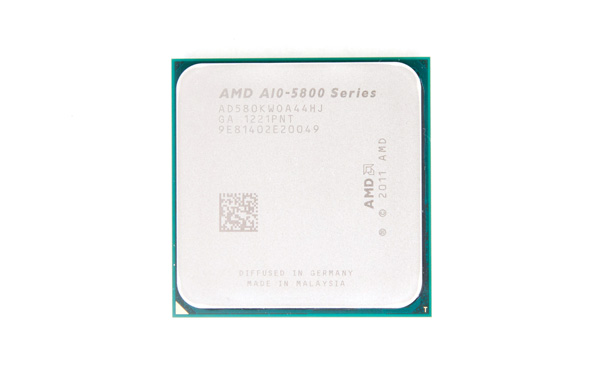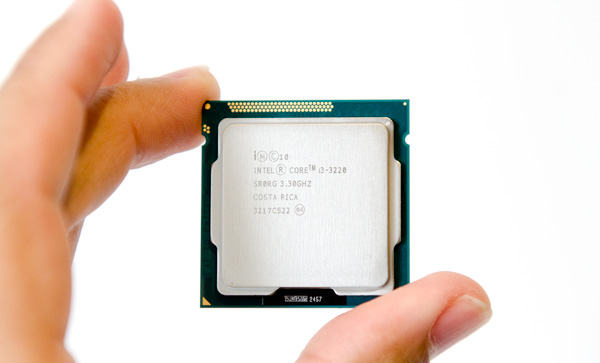AMD A10-5800K & A8-5600K Review: Trinity on the Desktop, Part 2
by Anand Lal Shimpi on October 2, 2012 1:45 AM ESTAlthough AMD's second-generation mainstream APU platform, codename Trinity, launched months ago in notebooks the official desktop launch is today. Rumor has it that AMD purposefully delayed the desktop Trinity launch to clear out unsold Llano inventories in the channel. Although selling APUs in notebooks is pretty easy, convincing desktop users to forgo the discrete GPU option (and ignore Intel) has been a tough battle for AMD. I keep going back to two slides that show us where AMD wants to go and the cores it'll take to get there:

The ultimate goal is this beautiful cohesive operation between CPU and GPU on a single die. That future will require a lot of software support, not only at the application level but also at the OS level. And I'm not talking about Windows 8. We're still far away from this APU dominated future, but AMD is marching in that direction. The second slide shows the x86 cores that we'll see from AMD along the way. AMD is still playing catch-up in the x86 CPU space and it's got a lot of lost time to make up for. There's no hiding the fact this is going to be a multi-year effort to simply get close to Intel's single-threaded x86 performance. Through pricing, leveraging its GPU technology and throwing more transistors at the problem AMD can still deliver competitive solutions, but it's not going to be a walk in the park.
Last week we took a look at the GPU side of the desktop Trinity APUs. We looked at the top end 384-core Radeon HD 7660D configuration as well as the slightly slower 256-core Radeon HD 7560D GPU, both of which easily outperformed Intel's HD 4000 and HD 2500. As far as processor graphics go, Trinity on the desktop maintains a healthy lead over Intel. There's still a place for discrete GPUs but that's pretty much at the $100 and above price points.
Today we're able to talk about pricing and x86 CPU performance among other things. The good news on that front is the most expensive Trinity APU is fully unlocked and is priced at $122:
| AMD Socket-FM2 Lineup | ||||||||
| Modules/Cores | CPU Clock Base/Turbo | L2 Cache | GPU | TDP | Price | |||
| A10-5800K | 2 / 4 | 3.8 / 4.2 GHz | 4MB | 384 cores @ 800MHz | 100W | $122 | ||
| A10-5700 | 2 / 4 | 3.4 / 4.0 GHz | 4MB | 384 cores @ 760MHz | 65W | $122 | ||
| A8-5600K | 2 / 4 | 3.6 / 3.9 GHz | 4MB | 256 cores @ 760MHz | 100W | $101 | ||
| A8-5500 | 2 / 4 | 3.2 / 3.7 GHz | 4MB | 256 cores @ 760MHz | 65W | $101 | ||
| A6-5400K | 1 / 2 | 3.6 / 3.8 GHz | 1MB | 192 cores @ 760MHz | 65W | $67 | ||
| A4-5300 | 1 / 2 | 3.4 / 3.6 GHz | 1MB | 128 cores @ 724MHz | 65W | $53 | ||
| Athlon X4 750K | 2 / 4 | 3.4 / 4.0 GHz | 4MB | N/A | 100W | $81 | ||
| Athlon X4 740 | 2 / 4 | 3.2 / 3.7 GHz | 4MB | N/A | 65W | $71 | ||
Compare this to Llano's launch where the top end SKU launched at $135 and you'll see that AMD is somewhat getting with the times. I would still like to see something closer to $100 for the A10-5800K, but I find that I'm usually asking for a better deal than what most CPU makers are willing to give me.
AMD's competitive target is Intel's newly released Ivy Bridge Core i3 processors. There are only five Core i3s on the market today, four of which use Intel's HD 2500 graphics. The cheapest of the lineup is the Core i3 3220 with two cores running at 3.3GHz for $125. Intel disables turbo and other features (there's effectively no overclocking on these parts), which AMD is attempting to exploit by pitting its Trinity K-series SKUs (fully unlocked) against them. AMD's TDPs are noticeably higher (100W for the higher end K-series parts compared to 55W for the Core i3s). Intel will easily maintain the power advantage as a result under both CPU and GPU load, although AMD's GPU does deliver more performance per watt. Power consumption is a major concern of AMD's at this point. Without a new process node to move to for a while, AMD is hoping to rely on some design tricks to improve things in the future.
At the low end of the stack there are also two Athlon X4s without any active GPU if you just want a traditional Trinity CPU.
The Test
This will be our last CPU/APU review on the current test platform/software configuration. The next major CPU review will see a move to a brand new testbed running Windows 8. As always you can get access to far more numbers than what we report here if you use our performance comparison engine: Bench. Of course if you want to see the GPU and GPU Compute performance of AMD's Trinity APU check out part one of our coverage.
| Motherboard: |
ASUS P8Z68-V Pro (Intel Z68) ASUS Crosshair V Formula (AMD 990FX) Gigabyte GA-F2A85X-UP4 (AMD A85X) Intel DZ77GA-70K (Intel Z77) |
| Hard Disk: |
Intel X25-M SSD (80GB) Crucial RealSSD C300 OCZ Agility 3 (240GB) |
| Memory: | 2 x 4GB G.Skill Ripjaws X DDR3-1600 9-9-9-20 |
| Video Card: |
ATI Radeon HD 5870 (Windows 7) AMD Processor Graphics Intel Processor Graphics |
| Video Drivers: | AMD Catalyst 12.8 |
| Desktop Resolution: | 1920 x 1200 |
| OS: | Windows 7 x64 |













178 Comments
View All Comments
Roland00Address - Tuesday, October 2, 2012 - link
1 watt *1000 hours equals 1 Kilowatt hour which is abbreviated 1 kWh24 hours a day *365 days per year equals 8760 hours or 8.76 kWh
I should have said 24 hours a day, 7 days a week, 52 weeks a year. I apologize for leaving off the 52 weeks a year part it was a slip of the tongue.
KAlmquist - Tuesday, October 2, 2012 - link
Good point. By my calculations, the break even point between the AMD A10 and the Intel i3 occurs when the amount of computation you are doing has the busy A10 doing 14.5% of the time and the i3 is busy 16.5% of the time. That assumes that the computation you are doing is similar to the second pass of x264 HD; the numbers might be different with a different work load. I do know that my computer is busy much less than 15% of the time. Right now, for example, I am using the computer to enter this comment, and the CPU is basically idle.Of course Visual is right that power use under max load does matter even if your system is idle most of the time. But after seeing how Bulldozer fared against Sandy Bridge, I expected Ivy Bridge to crush Piledriver (the Trinity CPU) in power consumption. You can argue that Ivy Bridge still wins, but it is a big surprise (at least to me) that it is a close call.
bgt - Tuesday, October 2, 2012 - link
I also believe the experience is important too. Since I use Intel and AMD PC's I often found the bench numbers a bit meaningless. Intel CPU's may be fast at small single threaded jobs but AMD is often better at big workloads. When the A10-5800 is out here I will compare it to my 3225, used in a HTPC. I already noticed a difference in graphic display between my 3850 and 3225 when watching a HD movie on my TV. The screen looks a bit hazy,foggy when the 3225 is used. Compared to the 3850 I mean.Contrast is not as nice. Deep black is not really black.nevertell - Tuesday, October 2, 2012 - link
It would've been really great if you had included Phenom II and Athlon II cpus, to see whether or not it is reasonable for someone owning those systems to upgrade to the new APU's. AFAIK, I still think these CPUs are relevant to the general consumer, as long as they are in stock.Medallish - Tuesday, October 2, 2012 - link
I still run on my Phenom II X4 965@ 3.8GHz, it's a wonderful CPU, although I suspect it will be replaced by Vishera soon.Mickatroid - Tuesday, October 2, 2012 - link
Me too. A C3 stepping at 3.9 with a modest over volting. I am planning a micro-ITX trinity for my new workshop computer in a custom box with a car air filter (my Athlon XP is well past it).The good news is that for basic stuff (and more besides) Trinity offers all the computing powered I could ask for.
Roland00Address - Tuesday, October 2, 2012 - link
Click bench in the upper corner of the website and enter the two processors you want to compare.The A10 5800k gets roughly the same performance as the phenom ii x4 965
mikato - Wednesday, October 3, 2012 - link
Wow! Glad you mentioned this. I have a Phenom II X4 965 and plan to keep it for quite a while yet and it's as fast as anything (that I would notice). With that in mind, an A10 5800k would be a beast for my parents build or an HTPC. Better yet a 5700 if I can get one.owlxp - Tuesday, October 2, 2012 - link
Why even do the comparison with high end discrete cards? Everyone knew what those results were going to look like. We've known for months. Despite the "i5 performace at i3 prices" marketing, AMD can't compete with the better intel CPU's............but that's not where the value is. AMD dominates the low end market and the bang for buck. Why is there no review on what the max discrete card that can be used in the hybrid xfire set ups? What about some tests to see if Trinity can do multi-discrete + on die GPU triple and quad xfire? That's what I'd like to see. There were some reviews comparing radeon 7750 in crossfire to nvidia's 640, 650, and 660 and the dual 7750 set up was winning the 1080p with 4x and 8x aa on match up. If the a10 + 7750 can put out similar results.........that's going to be an easy way to capture the budget and midrange gamers. Especially if triple and quad hybrid xfire set ups are possible.Where is the value test and the chart for the hybrid xfire set ups? That's what I want to see.
meloz - Tuesday, October 2, 2012 - link
>AMD can't compete with the better intel CPU's............but that's not where the value is.If there's no value there, please alert Intel. They didn't get the memo, nor did the consumers. Inspite of making CPUs with "poor value", Intel outsell AMD 9:1 _and_ make record profits quarter after quarter.
>AMD dominates the low end market and the bang for buck.
And in the process AMD make losses, quarter after quarter.
No one wants to "dominate" the low end, broseph. Low end is where you naturally end up if you are not good enough to compete with the top and mid end.